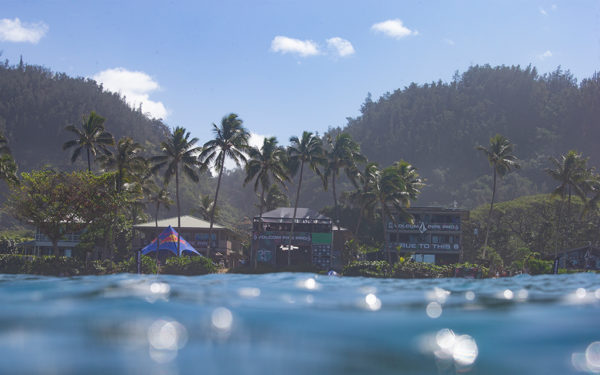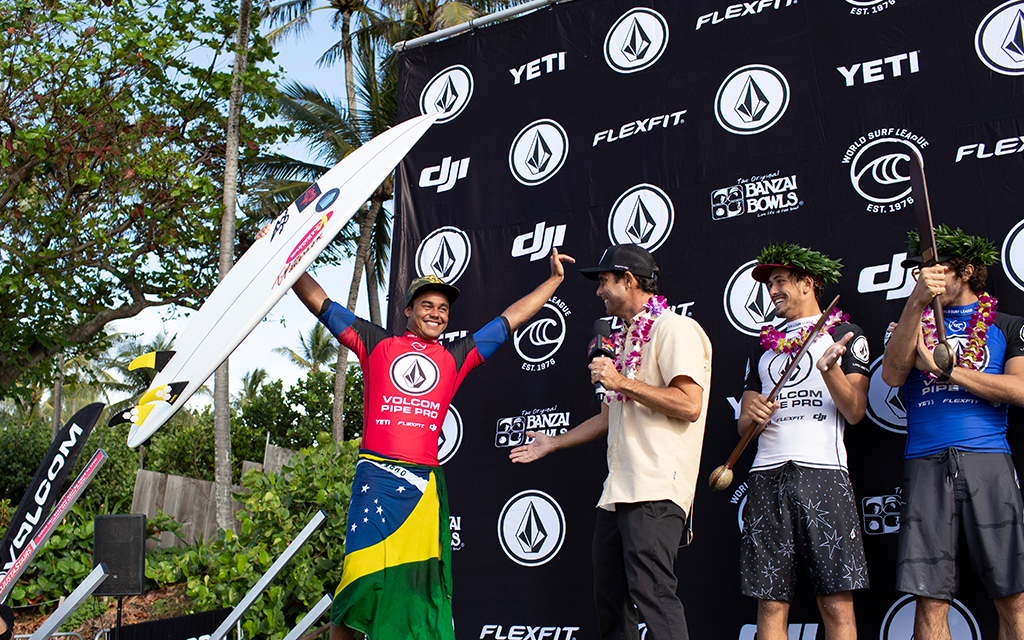I longboard, own a pair of Vans, have lived near the ocean my entire life and bring up William Finnegan’s Barbarian Days at parties.
But while I’ve long loved the idea of surfing, I’d never actually attended a surfing competition … until last week’s Volcom Pipe Pro, a Qualifying Series Championship on Oahu’s North Shore, at the fabled Banzai Pipeline. Below, my 10 takeaways, confessions, observations and conclusions as a first-time spectator.

How it works
Now 11 years in, the Volcom Pipe Pro is a four-day surf competition hosted at Oahu’s North Shore at the end of each January. Nearly 150 of the world’s best surfers compete in the event, and it’s an inclusive mix: top-dogs from the World Surf League tour (a roster of 34 guys who compete across 11 events each year to win the title), up-and-comers using the weekend to rack up points (a strong showing might help them reach the tour) and freesurfers endorsed by apparel companies or energy drinks.
Surfers head out into the water in heats of four, wearing blue, green, red and white. They surf for half an hour, catching waves that are judged on a score from 0-10 (to the tenth decimal point). Getting barreled, landing cool turns, not wiping out, etc. all lead to a good score. Stealing someone else’s wave results in a penalty. The total of your top two waves is your score.
That such a democratic event happens at Pipeline is a bit of an anomaly; it’s the only Championship Tour wave that hosts non-League surfers, which adds to the wave’s legend. Pipeline is also a big wave with a preposterously shallow reef: it’s long been the wave young surfers head to in the winter to take their licks and prove their worth, a sort of tropical Rucker Park, and Volcom’s event ensures that all those hours spent ripping open knees and elbows on the coral will actually lead to professional, high-def attention.
Drones are here to stay
The Volcom Pipe Pro is broadcast on Red Bull TV, which uses a fleet of drones to capture the vertical backside snaps right along with the wipeouts and broken boards. Red Bull films adrenaline-heavy events all year long — skateboarding in Estonia, downhill mountain-bike racing in Colombia — and has this thing figured out. I got a chance to peak into their command center, an air-conditioned complex behind Volcom’s iconic Pipeline-facing beach house where producers send drones out on missions over the reef, and it’s clear that the technology is a total game-changer. Kelly Slater’s generation exploded onto the scene in the ’90s for surfing Pipeline, backed by a 35-minute, Taylor Steele-directed VHS film entitled Momentum. Just being able to run back one’s surfing in that day and age was revolutionary. In this era, every single angle is captured. And if you missed the event entirely, you can catch it here.
… and so are the Brazilians
During a heat on the third day, one of the commentators went on a tangent about surfing and the Olympics. He remarked how it was a bit odd that Hawaiians would be surfing with the Americans in Tokyo, and the merger should make the American team a global powerhouse. Huh? I tried to shake some water out of my ear. I’d had a surf lesson of my own the day before, and figured I hadn’t heard him correctly. It’s true, though: since 1976, the WSL has indeed recognized Hawaii as a sovereign surfing nation. The infusion of the 50th state will ensure the American Olympic team can rely on Hawaiian legends like John John Florence and Seth Monix (who finished fourth in the Volcom Pipe Pro).
Not a unified American front nor the immutable Australians, though, will have an easy time holding off the Brazilians. They claim arguable the best surfer in the world right now in Italo Ferreira, eight of the top 25 surfers in the world, and just placed three in the top four at Volcom Pipe Pro. Much to my excitement, the man with the best name in the entire competition, Wiggolly Dantas, brought home first prize.
Remember Eli Hanneman
A name to chat about at the water cooler (if, for some reason your office is really into surfing) is this 17-year-old from Maui who didn’t make it to the finals. He’s the next big thing in the sport: a departure from old-school power surfing toward highly technical turns and flashy finishes. For those curious, Eli and other young surfers like him commonly take online classes from a very young age in order to travel and maximize their time in the ocean.
Helmets are on the horizon
I got the chance to sit down with Jamie O’Brien at one point over the weekend, a Red Bull surfer and former Pipeline Master winner who grew up on the North Shore and now lives in a three-story house just behind the Volcom House. From his back deck, Jamie can check if the surf is good during his morning coffee. He mentioned multiple occasions when surfers out in the water battling heavy conditions hit their heads on the reef below. Jamie had to paddle out blindly with his board to try and save their lives.
He was successful, twice, in pulling them out of the ocean. But they might not have been so lucky: when surfers hit their head on the shallow reef at Pipeline, they knock themselves out and begin taking on water. Before long, their faces turn blue. While there isn’t much to be done about the vengeful, biblical power of a brutal wave (other than hold more competitions in surf-ranch wave pools), there is a growing movement for surfers to wear helmets.
Jamie, now 36, is all for it. He said, “I’ve accomplished all I set out to. At this point in my career, all I can do is be a good role model for the young guys and champion safe practices.” He also recently helped develop a surfing bodysuit with a built-in flotation device.
Otherworldly açai
Ballparks have chicken buckets. Pipeline has açai bowls with fresh berries and bananas. Shout out to Banzai Bowls.
It’s a model for sustainable partnerships
It’s pretty cool to see a professional sports league that doesn’t compromise on any of its participants’ core values. The Michael Jordan of the sport owns a sustainable apparel company, after all. At Volcom Pipe Pro, tents for Sustainable Coastlines Hawaii, a nonprofit devoted to hands-on beach cleanups, were everywhere. Its biggest branded sponsor, meanwhile (aside from the obvious), was YETI, which has taken hard (re: correct) stances on conservation and gun laws. Not to mention the event is acutely aware of the complicated sociopolitical history of the state that hosts it: it gave $45,000 to the Boys and Girls Club of Hawaii and the Live Like Sion Foundation, which was three times the size of the winning purse for Wiggolly Dantas.

CBD is everywhere
It’s inescapable! I tried two types of “Truly Cool” Volcom CBD. One is meant for deep tissue relief, the other for application after a shower at the end of a long day in the sun. Both situations are relevant to surfers, obviously, and I found both lotions … tingly. They felt good. Did they actually do any good? That’s a question for a different article.
The live commentary is excellent
In-person surf spectating is an odd experience because the surfers often disappear behind waves or blend into the horizon. Sometimes seven or eight minutes can go by and little to no action happens. It’s easy, in these moments, to take a nap on the beach. I did it once or twice. But the commentators did an admirable job of contextualizing moves, non-moves, conditions, etc.
It’s a vibe
Like anywhere else, Hawaii has its share of issues, protests and inequality. And surfing itself has a dark history of territorialism and violence. But at the Volcom Pipe Pro, at least, the Hawaii-surfer-stoned-on-life stereotype proved delightfully true. Surfers who didn’t make it out of their heats, even those who trudged in with broken boards and bloody limbs, chuckled and congratulated their competitors. The crowd cheered for any barrel or good wave, similar to the kind of unanimous support one finds at a marathon. Money and notoriety was on the line, sort of, but you wouldn’t have known it when Wiggolly Dantas was carried onto the beach like Rudy atop the shoulders of countrymen he’d just beaten. The workers — from Volcom to Sustainable Oceans — are relentlessly kind, and not that it matters, but everyone’s disarmingly beautiful, too. Pipeline is a mecca. And although the stairs down from the Volcom House to the beach have a tricky, un-nailed step (I memorized which one to hop over the two afternoons I was there), the place in general is as welcoming as the community who chat and applaud from the shoreline, always making room for another on the tour.
Subscribe here for our free daily newsletter.





Recent Comments